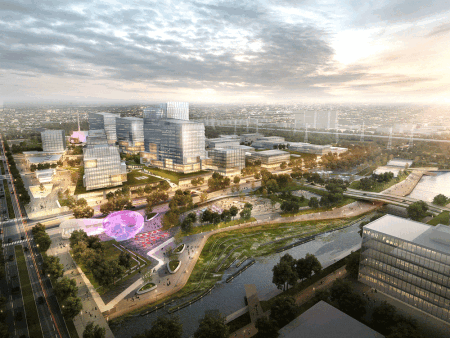Though the pace of China’s growth over recent decades meant innovation in land use often lagged the speed of development as a priority, this is changing due to a need for more sustainable and efficient development. Indeed, the country is undergoing a sea change in the way land is used, and for the better, says Albert Chan, director of development planning and design at Chinese developer Shui On Land.
A number of obstacles hinder more innovative land use, Chan says. Most cities are planned with separation between new residential and commercial areas. Furthermore, strict “rights to light” mean that Chinese residential developments tend to be built in regimented north-to-south lines.
“In recent years, cities have developed quickly and spread widely, using a lot of land,” says Chan. “This means land is not used as efficiently or as innovatively as it could be.” But he says this is beginning to change.
2017 ULI Asia Pacific Summit in Singapore: Register | Sponsor
Shanghai has committed to no further expansion of developed land, meaning plots must be used more carefully. The Shanghai 2040 master plan aims to limit the city’s population to 25 million people by 2040, a small increase from the 24.3 million people living there now. The total land area allocated for construction will be limited to 1,235 square miles (3,200 sq km), meaning only land already developed can be used.
“Shanghai aims to become an excellent global city—an international economic, finance, trade, shipping, and scientific innovation center, as well as a cultural metropolis,” says Zhuang Shaoqin, director of the city’s planning, land, and resources administration. It will become an “innovative, humanistic, and ecofriendly city.”
Chan says the master plans mean the city is “seeing more creative and sustainable use of land, as well as preservation of historic buildings.”
Julian Wei, director of planning and urban design for the Shanghai office of the design firm Sasaki, says the Shanghai Yuqiao Science and Technology Park, which was completed last year, shows how new thinking can be applied to projects in the city.
The development, which was showcased at the ULI Chinese Mainland Winter Meeting in Shanghai in December, has a mix of commercial, research and development, cultural, and retail space, connected by public open space. The project’s design has “led with landscape,” Wei says. “The open space creates a continuity of active parks, streets, and plazas, but also reflects the activity within the buildings,” he said.
The innovation cluster, covering more than 300 acres (120 ha), was built at a relatively low level for China and with a mix of densities. It is directly linked to one of Shanghai’s metro lines, which forms the basis for a transport node in the development that is linked to a commercial node as well as a cultural node.
The park uses outdoor and indoor space in an original way, blending open indoor public space and outdoor space on multiple levels. The designer says it has “deliberately blurred” the distinction between public and private space. Pedestrian routes—often wide spaces—link the park and break up the blocks of development.
Shui On Land has been a pioneer in development in China: its Xintiandi mixed-use development in Shanghai has become an icon for live/work/play development. The developer’s scheme at Hongqiao, Shanghai, is an example of development close to a transport node, something increasingly important in China.
Meanwhile, Shui On’s Knowledge and Innovation Community (KIC) mixed-use project at Yangpu in Shanghai is transforming a formerly industrial area into a new community with residential and knowledge-based live/work/play/learn uses.
“Developers and planners in China need to become more focused on community and on the spaces in between the developed areas—the streets, parks and plazas—which make a development a community,” says Chan. He notes that recent buyers of apartments in Xintiandi cite the community feel as a major reason for buying there.

The park uses outdoor and indoor space in an original way, blending open indoor public space and outdoor space on multiple levels. The designer says it has “deliberately blurred” the distinction between public and private space. Pedestrian routes—often wide spaces—link the park and break up the blocks of development. (Sasaki Associates)
Wei adds that the development of smart cities, which use big data and the “internet of things” to track and manage factors such as traffic, energy use, and public services, will become increasingly important in driving land use and development.
“The smart city really allows you to log data for sustainability reports, and to project population growth and see how they are using the space,” he says. “We have been able to track a whole neighborhood so we can see how a development is utilized.”
While China has rules governing planning and building, Chan argues that with good communication and good ideas, planners and developers can change things for the better. “There is more flexibility than people think,” he says. “Furthermore, many zoning plans have not kept up with changes in China, so they need to adapt.”






